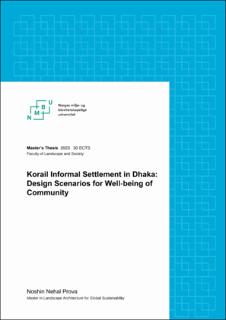| dc.description.abstract | The proliferation of informal settlements represents a pervasive global trend. Over the past three decades, in excess of 213 million individuals have inhabited these informal habitats, constituting approximately 25% of the world's urban population (Avis, 2016) Notably, these settlements often gravitate towards water structures within the urban fabric, fostering distinctive cultural practices. Regrettably, these informal settlements are frequently perceived as eyesores, contributing to both visual and social pollution. Consequently, the informal sectors of cities have become isolated entities within the broader formal urban landscape . (Dovey, 2012)
In response to this pressing issue, this project embarks on a journey to explore the potential of landscape architecture as a transformative force. It seeks to enact a design intervention with the overarching goal of considering the overall wellbeing of the informal community. The impetus for this endeavor springs from the author's deep-seated fascination, rooted in personal experiences originating from a developing country in South Asia. The rapid urbanization and burgeoning population in cities have wrought profound changes, eradicating traditional ways of living. Dhaka, the capital of Bangladesh, stands as a poignant example of this transformation. The relentless influx of migrants has not only exacerbated environmental challenges but has also given rise to a critical housing shortage. In response, local residents have resorted to establishing informal settlements, often along watersheds and open spaces, resulting in the expansion of areas such as the Korail Slum, notably situated by the Gulshan Lake. This project in landscape architecture aims to redefine informal settlements, focusing on both providing opportunities for affected individuals and addressing environmental degradation. Beyond physical restructuring, the goal is to create safe spaces, foster community engagement, and generate economic opportunities, particularly for women. The overarching objective is seamless integration into the city's natural landscape, revitalizing the informal sector for sustainable living while shaping the environment in a way that enhances the quality of life for the urban poor. Central to this vision is leveraging informal settlements as intermediary spaces that foster a symbiotic relationship between formal and informal city elements | |
